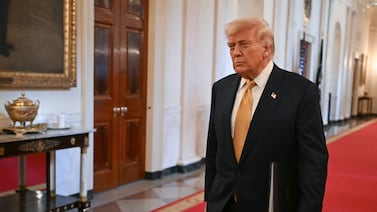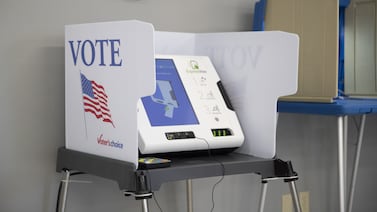Fourteen secretaries of state and chief election officials implored House Speaker Nancy Pelosi and Senate Majority Leader Chuck Schumer in a letter Wednesday to include $20 billion in the federal budget for election funding over the next 10 years. The letter is the latest plea from election administrators who just weeks ago endured a major setback in their push for new election assistance.
“We know that the challenges before you are great, and that difficult prioritization decisions must be made. But we want to be sure you know how acute our needs are,” they wrote, citing voting machines that require urgent replacement, threats to the safety of election officials, and budgets decimated by the pandemic.
These state officials, all Democrats, along with dozens of bipartisan county officials across the country have spent months asking congressional leaders to prioritize this funding.
Maine Secretary of State Shenna Bellows, who signed the letter, told Votebeat “a sustainable source of federal funding, especially in light of ever evolving security threats” was necessary to ensure the security of elections. Maine’s voter registration system, which serves almost 500 municipalities who all independently access the platform, was built in 2007. “It’s 14 years old, and it’s fundamental to everything we do,” she said. “There are, obviously, limitations on its utility and I think it’s a vulnerability in the future. Fortunately, it’s served us well to date, but we desperately need to make those investments.”
The letter’s urgency demonstrates the reality for election administrators, who say they have been left holding the bag in the most divisive time for elections in modern history. The crumbling state of America’s voting machines, physical storage facilities, security standards, and audit practices have made repeated front page and chyron-grabbing news since the pandemic. Thousands of counties rely on Windows 7 to run their voting systems — a deeply outdated operating system no longer getting regular security updates. At least 13 states use voting machines purchased before the invention of the iPhone. Thousands of counties relied on privately funded grants distributed by two nonprofits — the Center for Tech and Civic Life and the Center for Election Innovation & Research — for protective equipment during the pandemic and to make long-needed upgrades to their systems. They also spent this money, and far more, on vote-by-mail equipment and staffing needs to accommodate voting in a pandemic.
State and local election officials have been asking for a consistent stream of federal funding for decades, but one has never come. Given the year’s clear focus on voting rights as a policy priority for Democrats, who now hold the White House and both chambers of Congress, these officials felt 2021 would finally be the year their effort would bear fruit. Instead, what they’re feeling is painful whiplash.
Many of the officials who signed the letter thought they’d already won their requested federal funding earlier this summer. For weeks leading up to the announcement of Senate Democrats’ $3.5 trillion budget resolution on Aug. 9, multiple legislators had told them that the resolution would include billions of dollars in election funding alongside the bill’s major priorities such as expanded education funding, climate change solutions, and workforce investment. Instead, elections received $0.
House Speaker Nancy Pelosi had abruptly changed her mind about election funding days before the announcement. Senators then removed the funding at her direct urging to keep the House and Senate priorities aligned. Any funding for election infrastructure, she told them, would reduce the urgency around the For the People Act.
“I thought it was a done deal,” one state election official said, declining to be named so that he would not fall out of favor with congressional leaders. He said he was “heartbroken” when he saw the news. “I know that sounds crazy, but this was the first time the federal government was supposed to offer predictable funding to elections and now it’s just gone.”
The predictability is critical to the improvement of election infrastructure in the long term, said Tiana Epps-Johnson, co-founder of the Center for Tech and Civic Life. She said that in order for counties to offer consistently positive voting experiences, and to attract more participation, local governments must plan investments long into the future. “Concretely, that planning means election officials can proactively communicate how to navigate their communities so that everyone is invited in,” she said.
Cathy Darling Allen is the clerk in Shasta County, Calif. — a predominantly Republican, Northern California county where she serves as an elected Democrat. She began working in elections in 2003, and has been asking for federal funding since that time. She felt deflated to see the Democratic Party change course on what was widely viewed to be the last, best chance for funding this year.
“Elections is kind of the red-headed stepchild, and it always has been,” she said. She’s watched her own staff and colleagues across the country be threatened with their lives as they tried to hold an election in extraordinary circumstances with limited resources. “None of us signed up to be law enforcement officers. We didn’t sign up to risk our lives,” she said. The dire nature of the depleting resources and increasing distrust has, she said, “not sunk in with our representatives in Washington.”
Election officials began to feel they had clinched the funding in the reconciliation package on Aug. 5, when Politico published a story foreshadowing the Democrats’ plans. Including it in the reconciliation package, the authors wrote, might be “the only realistic opportunity for congressional Democrats to do something concrete on voting ahead of next fall’s midterms.”
Sen. Amy Klobuchar had been advocating for the funding to be included in the package for months, as had Rep. Steny Hoyer in his chamber, Politico reported and Votebeat has independently confirmed. There were no signs of problems until days before the bill’s contents were finalized.
Pelosi’s decision, according to participants in the negotiations, was heavily influenced by Rep. John Sarbanes, the author of the For the People Act. Sarbanes and his aides convinced Pelosi that providing the funding now would compromise their remaining leverage over Senate Democrats to force passage of the act, said people involved in the discussion, including several House and Senate senior staff and state elections officials.
Pelosi’s publicly stated reason for opposing the funding in the budget reconciliation is that Congress then cannot control how a state may spend the money, according to her spokesman Drew Hammill, who said she is concerned that when providing that money without guardrails, “any governor could use it to suppress the vote.” Others who have spoken with Pelosi and Sarbanes say they believe any election funding should be withheld until the passage of the For the People Act.
Advocates and experts say Pelosi’s plan represents an unrealistic level of optimism for the bill’s future, which currently has no viable path forward without meeting Sen. Joe Manchin’s demands for scaling it down — a rewrite that is still in the works. Both Pelosi and Sarbanes have vocally opposed breaking up the bill or removing any of its many provisions, say staffers and advocates with whom they’ve spoken.
Klobuchar, who received no warning of Pelosi’s sudden decision, was angered and shocked, according to multiple people who talked to her. In reaction, Klobuchar repurposed her election-funding plan — which offered $10 billion to state and local officials, available over a decade — into an amendment to the bipartisan infrastructure bill. The amendment, which wasn’t voted on, was a symbolic move to show her displeasure with Pelosi’s decision and an assurance to local election administrators that their voices were still being heard, one Democratic Hill staffer told Votebeat. “Klobuchar is trying to live in reality,” the staffer said. “She’s just trying to do something.”
Hammill, the Pelosi spokesman, told Votebeat that a plan of the type Klobuchar advocated was “not fully baked.” The reconciliation package, he said, was not “the appropriate vehicle” to distribute funds because under reconciliation rules, Congress cannot dictate specifically how the funds are used. “We support this funding, but it has to have safeguards,” he said. “And what was proposed does not.”
Pushed to explain the basis for Pelosi’s concern, Hammill said, “Governors can use the funds to do things that are not in furtherance of our democracy.” As an example, Hammill said, “Nothing would stop a governor, such as the governor of Texas, from using the funds to remove mail-in ballot boxes, drop-off boxes.” (Texas does not have drop boxes.)
In an emailed statement, a spokesperson for Rep. Sarbanes wrote, “Mr. Sarbanes has supported and continues to support much needed election infrastructure funding with important safeguards.”
Pelosi and Sarbanes have made this insistence about safeguards to advocates and state officials for months. Matt Masterson, the former chair of the Election Assistance Commission, the agency responsible for distribution of such funds, said it is false to suggest federal dollars given to states and counties to spend on election infrastructure are misspent. After all, it costs far less money to close polling locations and remove drop boxes, and state legislatures across the country have been doing this without any additional spending since the 2020 election. The EAC has, for nearly two decades, distributed this money without finding a pattern of the behavior Hammill describes.
“In fact, the surest way to guarantee voters will no longer have the options or access they are used to is to worry more about guardrails you desire than the resources officials desperately need,” he said. “After what election officials went through in 2020, there is absolutely no excuse not to invest in them. Failing to support them because you don’t trust them completely ignores their history of responsibly spending money to serve voters and protect their systems.”
Hammill said Pelosi’s preference was to apportion money to states and local offices in the normal appropriations process following the passage of the For the People Act. He said Pelosi and the other supporters of the bill had every intention of ensuring states have the money they need to make the specific changes authorized by the bill. But there is, history shows, no guarantee of sufficient funding after the passage of voting bills. Election offices often suffer the consequences of poorly funded legislative requirements even decades later.
Epps-Johnson of CTCL says that counties were so desperate for funding in 2020 that dozens described even the purchase of basic supplies as revelations. The combination of creative work on behalf of election officials alongside last-minute federal and private grants made 2020 a success against all odds, and Epps-Johnson called this “a miracle, given the outdated systems they are using to do that work.” She said that even after her years of experience in elections she was surprised at how small some unmet needs were. “We even heard from one local election department in Texas with about 1,200 voters, which was able to purchase ‘Vote Here’ signs and ‘I Voted’ stickers for the very first time,” she said.
As it has become clear to nonprofit groups and election workers that the federal government is unlikely to provide a new, consistent stream of funds, they are left to grapple for dwindling resources from their counties and states, which have so far expressed similar lack of interest in paying for election upgrades.
Darling Allen, the clerk in Northern California, said she must “go toe to toe at budget hearings with law enforcement” over county dollars — a fight she rarely wins. “Our voters are very clear in our community that they prize law enforcement and public safety above all else,” she said. The federal support “would have provided a baseline of ongoing maintenance funding we could have counted on in the local level that would have given us some shelter from things like budget cuts and economic downturns that we have no control over.”
“There are so many opportunities to fund elections, and the infrastructure and reconciliation packages were two of the clearest shots,” said Chris Krebs, the director of the Department of Homeland Security’s Cybersecurity and Infrastructure Security Agency during the Trump administration, who has long advocated for large increases in funding on election infrastructure.
With Pelosi and Sarbanes apparently intending to, as one House staffer put it, “hold election funding hostage” pending the passage of the For the People Act, there is currently no obvious path forward for a large infusion of funds for election infrastructure this year. While Pelosi’s office and other Democrats have said they will strive to provide such funding ahead of 2022’s federal midterms, local election officials are left to manage local elections happening nearly every day across the country with the resources they have now.
“One of the most exciting things to come out of the 2020 election is that local election officials are increasingly finding their voice and stepping up to talk about the realities of what administering elections look like on a daily basis,” said Epps-Johnson. She is hopeful that their ability to describe their circumstances and advocate for themselves will lead to “us closer to the Democracy we say we are about.”
None of the staffers or representatives across nine House and Senate offices Votebeat spoke with could articulate a clear vision for implementing funding now that Pelosi has determined to wait until the Senate’s passage of the For the People Act to loosen the purse strings. Democratic senators and staffers have expressed public doubt at their ability to do so for months, and little has changed.
“There is a lot of work to do to educate lawmakers and the American public about what it takes to run elections that Americans actually deserve,” Epps-Johnson said. “There is still a learning curve we need to tackle in order to shine light on these fundamentals of our system, which could be bolstered in a way that gets us closer to the Democracy we say we are about.”






